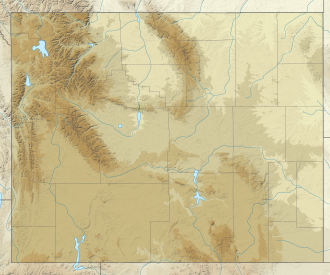| Crowheart Butte | |
|---|---|
 Crowheart Butte from the southeast, 2022 | |
| Highest point | |
| Elevation | 6,772 ft (2,064 m) [1] |
| Prominence | 700 ft (210 m) |
| Coordinates | 43°18′37″N109°05′41″W / 43.31023°N 109.09485°W |
| Geography | |
Location of Crowheart Butte in Wyoming | |
Crowheart Butte is a summit located in the Wind River Valley in rural Fremont County, Wyoming. [1] The community of Crowheart is located nearby.
Crowheart Butte was named after an 1866 battle between the Shoshone and Crow tribes. According to legend, following a five-day battle for hunting rights in the Wind River Range, Chief Washakie of the Shoshone and Chief Big Robber of the Crow agreed to a duel to decide the winner. Chief Washakie slew his opponent, but impressed with his courage, cut out his heart and placed it on the end of his lance. [2]
